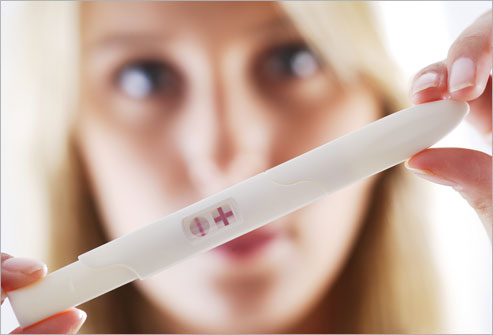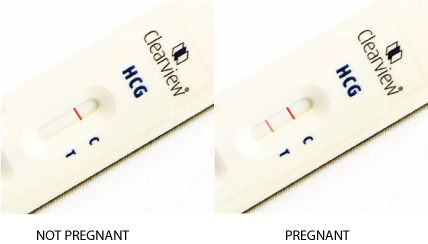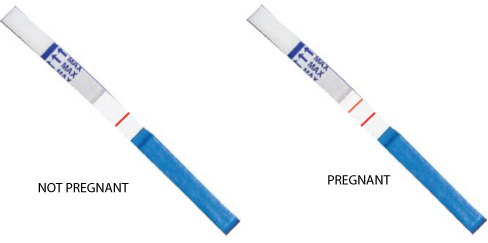What is a pregnancy test?
A pregnancy test is done to determine if a woman has conceived and is pregnant with a baby. When a woman gets pregnant, pregnancy hormone called the human chorionic gonadotropin (hCG) is released in the blood and the urine. Pregnancy test detects the hormone hCG and confirms the pregnancy. The amount of the hormone is directly proportional to the length of your pregnancy and thus, pregnancy test also determines how far the pregnancy has reached by detecting the level of the hormone present in the blood or urine.
When should you go for a pregnancy test?
It is best and recommended to carry out a home pregnancy test at least a week after you have a missed period to get a more accurate pregnancy result. Trying to detect it at a very early stage may not provide accurate result as the level of pregnancy hormone in the blood and urine may not be sufficient.
Types of pregnancy tests:
There are broadly 3 types of pregnancy tests: First is the Urine pregnancy test also known as the home pregnancy test (HPT), second and third are the clinical pregnancy tests named the pregnancy blood test and the Pelvic examination.
Once the home pregnancy test result is positive, a woman needs to go for the other two clinical tests as well in order to confirm the pregnancy and to determine the actual pregnancy length.
Urine pregnancy test /Home pregnancy test (HPT):
As the name suggests, urine pregnancy test is performed at home and that’s why it’s called the HPT.
There are different kinds of HPT kits available in the market. Each kit performs differently. Some may involve holding the pregnancy test strip in the urine stream, while other may involve collecting the urine and placing it drop wise on the strip.
How does home pregnancy test / Urine pregnancy test work?
HPT works by detecting the quantity of pregnancy hormone called the hCG released in the urine. The hormone shows up in the urine at least after 12-15 days of conception.
Types of urine pregnancy test kits:
- Pregnancy test strips
- Clear view
- Pregcolor card
- Pregtest card
- Veklocit
- Digital pregnancy strips
The various pregnancy test kits vary slightly from each other in terms of reading the test and placement of the urine. They use different signs to indicate the result. Some use lines, while others use other marks. There are kits which give digital reading as well.
How to take the urine pregnancy test using: Clear view, Pregcolor card, Pregtest card or Veklocit
- Take the urine pregnancy test at least a week after you have a missed period.
- The early morning first urine sample is the most preferred one as it contains more quantity of the pregnancy hormone hCG.
- Bring the pregnancy test strip to the room temperature before conducting the test.
- Read and follow all the instructions carefully.
Step 1: Collect the urine sample in a clean and dry container.
Step 2: Place the pregnancy strip (pregcolor card) on a flat surface.
Step 3: Take out 2-3 drops of urine from the container with the help of the dropper and gently drop it in the circular groove marked with ‘S’.
Step 4: As per the instruction, wait for 3-5 minutes and then look for the result.
How to read/ interpret the urine pregnancy test result?
- The pregcolor card or the clear view cards contain 2 regions marked as ‘T’ and ‘C’.
- ‘C’ region shows a permanent red band which is also called the comparison or the control band. ‘T’ region shows the test result.
- A red or purple color band shows at the ‘T’ region only when the test result is positive otherwise, one may observe only the ‘C’ band.
- A positive pregnancy test result will show 2 distinct red/ purple/pink bands in the ‘T’ and ‘C’ regions.
- In case the “T” region shows a dull and fainted pink band, it means the urine sample contains a low quantity of hCG hormone.
How to do the urine pregnancy test using pregnancy tests strips/ dip strips
Step 1: Collect the urine sample in a clean and dry container.
Step 2: While holding the strip from the blue side, dip the pregnancy test strip in the urine sample up to the stop mark/ max line and hold it vertically for 3-5 seconds as per the instruction.
Step 3: Take out the strip from the container and place it on a flat surface for 5 minutes to get the result.
How to read/ interpret the test result?
- You will observe a pinkish color solution developing at the test area while waiting for the result. The solution gradually converts into red/pink bands that appear on the control ‘C’ and the test ‘T’ regions of the strip.
- A single line in the control region indicated no pregnancy.
- Two distinct lines in the control and the test region confirm pregnancy.
Factors that may affect / alter the urine pregnancy test results:
- Medicines that contain hCG tend to give a false positive pregnancy test result. Women who take pills with hCG may come across a false positive test result, which means a positive pregnancy result without being pregnant.
- Not following the instructions carefully or mishandling the kit may also alter the test results.
Digital urine pregnancy test:
The digital pregnancy test strips are one of the latest advancements in the home pregnancy test equipments. They detect the hormone in the urine and show the reading as “Pregnant” or “Not Pregnant” which makes it easier to read and interpret the test result.
In case, something went wrong with the previous test and you wish to take another test, you may have to wait for around an hour for the previous digital readings to fade away.
Clearblue digital pregnancy test is one such pregnancy detecting instrument available in the market.
Blood pregnancy test:
Blood pregnancy test is another test performed at a doctor’s clinic to determine pregnancy. A woman should go for a blood pregnancy test to further confirm the urine pregnancy test. In case the urine test result comes negative and you still feel pregnant, it is recommended to take a blood pregnancy test to eliminate all possible doubts regarding pregnancy.
Blood pregnancy test, as compared to urine pregnancy test gives more accurate and precise results.
A blood pregnancy test can be done on the first day of missed period, as it is able to detect the presence of the hormone hCG in the blood stream.
How is the blood pregnancy test performed?
A blood pregnancy test is performed at a doctor’s clinic. You first need to fix up an appointment with the health care provider.
The doctor will apply alcohol on a specific spot of the arm and then with the help of a syringe and needle, the doctor will take out the blood sample in a tube and send it to the laboratory for examination.
Types of Blood pregnancy tests:
There are two types of blood pregnancy tests. One is the quantitative test and the other is the qualitative test.
Quantitative blood test: Also called as the beta hCG. This type of test is considered the best as it not only confirms the pregnancy but also tells the actual length of the pregnancy. It works by detecting and reading the actual count of hCG hormone released in the blood. This helps measure pregnancy length. Quantitative blood test also helps in detecting any abnormality or pregnancy problems at a very early stage.
Qualitative blood test: This type of blood test only confirms the pregnancy by providing a simple ‘yes’ or ‘no’ answer.
Pelvic examination:
A pelvic examination is also done at a doctor’s clinic. Pelvic examination is done around 6-7 weeks later of missed period. The gynecologist performs the examination by inserting two fingers inside the vagina to check cervix. This helps the doctor to judge the size of the ovaries, fallopian tubes and the uterus that usually enlarges in case of pregnancy.



